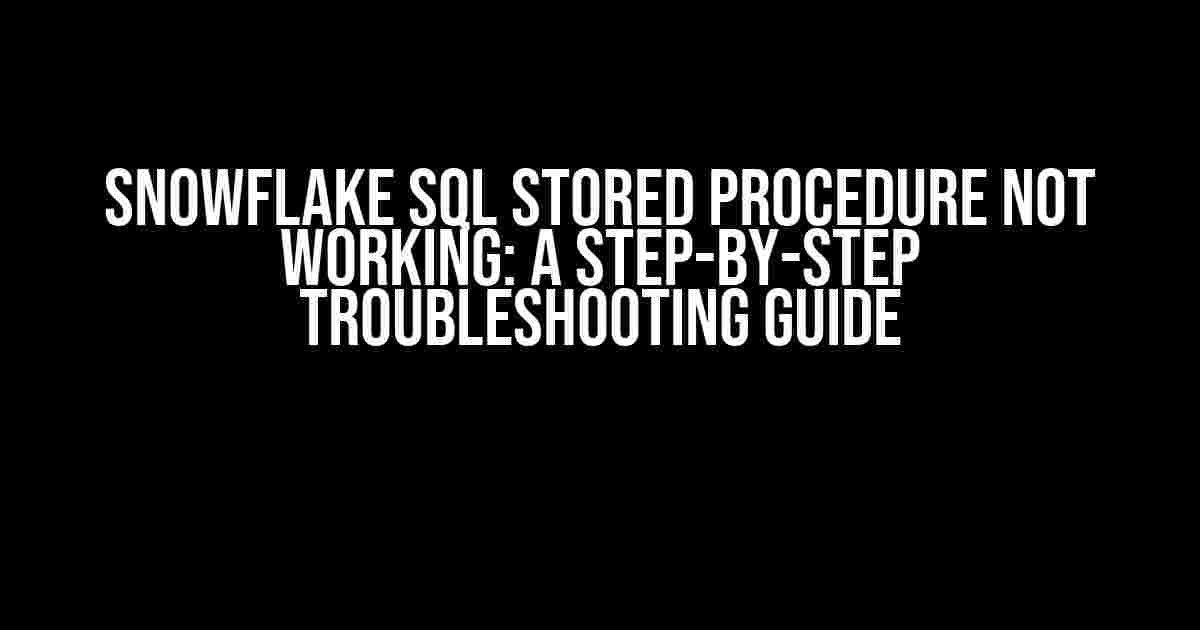Are you scratching your head, wondering why your Snowflake SQL stored procedure isn’t working as expected? Don’t worry, you’re not alone! In this comprehensive guide, we’ll take you on a journey to troubleshoot and resolve the most common issues that might be causing your stored procedure to malfunction.
Before We Dive In…
Before we start troubleshooting, make sure you’ve checked the following:
- Verify that you have the necessary privileges to create and execute stored procedures in Snowflake.
- Ensure that your Snowflake account is properly set up and configured.
- Check that your SQL client is connected to the correct Snowflake account and warehouse.
Common Issues and Solutions
Now that we’ve got the basics covered, let’s dive into some common issues that might be causing your stored procedure to fail:
Issue 1: Syntax Errors
The most common reason for a stored procedure not working is syntax errors. Snowflake has a specific syntax for creating stored procedures, and a single mistake can cause the entire procedure to fail.
CREATE OR REPLACE PROCEDURE my_procedure()
RETURNS VARIANT
LANGUAGE JAVASCRIPT
AS
$$
// Your code here
$$
;
Make sure to check for the following common syntax errors:
- Mismatched quotes or brackets
- Unclosed strings or comments
- Invalid or unsupported data types
- Incorrectly formatted JavaScript code
Issue 2: Permission Issues
Sometimes, even with the correct syntax, a stored procedure might not work due to permission issues. Ensure that the role executing the stored procedure has the necessary privileges:
GRANT EXECUTE ON PROCEDURE my_procedure TO ROLE my_role;
Verify that the role has the following privileges:
- EXECUTE privilege on the stored procedure
- SELECT privilege on the underlying tables
- INSERT, UPDATE, or DELETE privilege on the underlying tables (if necessary)
Issue 3: Data Type Mismatches
Data type mismatches can cause issues when dealing with Snowflake’s strict data type rules. Ensure that the data types in your stored procedure match the data types in your underlying tables:
| Snowflake Data Type | Example |
|---|---|
| VARCHAR | ‘Hello, World!’ |
| NUMBER | 12345 |
| DATE | ‘2022-01-01’ |
If you’re using JavaScript in your stored procedure, make sure to use the correct data type conversions:
let my_string = 'Hello, World!';
let my_number = 12345;
let my_date = '2022-01-01';
// Convert to Snowflake data types
let snowflake_string = `'${my_string}'`;
let snowflake_number = my_number;
let snowflake_date = `TO_DATE('${my_date}', 'YYYY-MM-DD')`;
Issue 4: JavaScript Errors
JavaScript errors can be stealthy and difficult to debug. Make sure to check for any JavaScript errors in your stored procedure:
try {
// Your code here
} catch (err) {
console.error(err);
throw err;
}
Use the `console.error` function to log any errors and exceptions. This will help you identify the issue and debug your stored procedure.
Troubleshooting Techniques
When all else fails, it’s time to get creative with troubleshooting techniques! Here are some methods to help you debug your stored procedure:
Method 1: Print Statements
Use print statements to debug your stored procedure. This will help you identify where the issue is occurring:
CREATE OR REPLACE PROCEDURE my_procedure()
RETURNS VARIANT
LANGUAGE JAVASCRIPT
AS
$$
console.log('Starting stored procedure...');
// Your code here
console.log('Ending stored procedure...');
$$
;
Method 2: Error Handling
Implement error handling to catch and log any errors that might occur:
CREATE OR REPLACE PROCEDURE my_procedure()
RETURNS VARIANT
LANGUAGE JAVASCRIPT
AS
$$
try {
// Your code here
} catch (err) {
console.error(err);
throw err;
}
$$
;
Method 3: Breakpoint Debugging
Use Snowflake’s built-in breakpoint debugging feature to step through your stored procedure line by line:
CREATE OR REPLACE PROCEDURE my_procedure()
RETURNS VARIANT
LANGUAGE JAVASCRIPT
AS
$$
// Your code here
// Set a breakpoint
debugger;
// Continue executing the stored procedure
$$
;
Use the Snowflake Web Interface or a compatible IDE to set breakpoints and debug your stored procedure.
Conclusion
Troubleshooting a Snowflake SQL stored procedure that’s not working can be a daunting task, but with these steps and techniques, you should be able to identify and resolve the issue. Remember to check for syntax errors, permission issues, data type mismatches, and JavaScript errors. Use troubleshooting techniques like print statements, error handling, and breakpoint debugging to debug your stored procedure.
By following this comprehensive guide, you’ll be well on your way to creating and executing successful Snowflake SQL stored procedures. Happy coding!
Frequently Asked Question
Stuck with a Snowflake SQL stored procedure that just won’t work? Don’t worry, we’ve got you covered! Here are some solutions to common issues that might be causing your stored procedure to fail.
Q1: Why is my Snowflake SQL stored procedure returning an error?
This could be due to a syntax error in your stored procedure code. Check for any typos, missing semicolons, or incorrect usage of Snowflake syntax. Try executing the code outside of the stored procedure to isolate the issue.
Q2: Why is my Snowflake SQL stored procedure not executing?
Make sure that the stored procedure is compiled correctly and there are no syntax errors. Also, check the roles and privileges assigned to the user executing the stored procedure. Ensure that the user has the necessary permissions to execute the procedure.
Q3: How do I troubleshoot a Snowflake SQL stored procedure that’s not working?
Use Snowflake’s built-in debugging features, such as the `RETURN` statement, to test and debug your stored procedure. You can also use the `SHOW PROCEDURES` command to check the stored procedure’s definition and `DESCRIBE PROCEDURE` to check the procedure’s signature.
Q4: Can I use a Snowflake SQL stored procedure to modify data in multiple tables?
Yes, you can use a stored procedure to modify data in multiple tables. However, be aware of the transactional behavior of stored procedures in Snowflake. If an error occurs in the procedure, all changes will be rolled back. Use `BEGIN` and `COMMIT` statements to control the transactional behavior.
Q5: How do I optimize the performance of a slow Snowflake SQL stored procedure?
Optimize the stored procedure’s performance by minimizing the number of queries, using efficient algorithms, and optimizing data access patterns. Additionally, consider recompiling the stored procedure with the `ALTER PROCEDURE` command to ensure it’s optimized for the latest Snowflake version.




